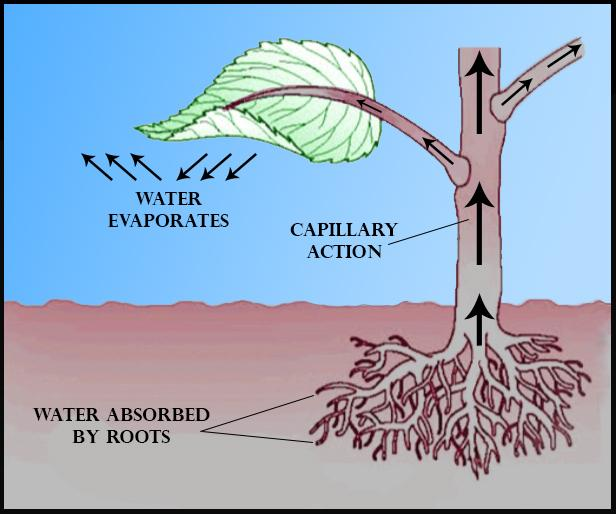
List the functions of the root.
Answer
484.8k+ views
Hint: Roots are under the surface of the soil and have a major role in the uptake of water and thus plants cannot survive without roots. Root holds the soil and also prevents soil erosion.
Complete answer:
The functions of the root are as follows:
-Roots help to anchor plants to the ground and provide structural support to the plant which enables it to grow upright. Primary roots give rise to secondary and tertiary roots which cling to solid and hold its form to support the plant even in extremely windy conditions. This property of the roots also prevents soil erosion.
-Water and minerals are absorbed from the soil by roots which is essential for the survival of the plant. The nutrients and water are transported through the vascular bundles which enable the plant to grow.
-Roots of some plants also help to form symbiotic relations with nitrogen-fixing bacteria which proves to be extremely beneficial for the plant. Microorganisms like rhizobium live in root nodules and fix atmospheric nitrogen so it's usable for the plants in exchange for nutrients.
-In some plants like carrot, the photosynthetic products of the leaves are transported to the stem for storage and future use.
-In plants growing in waterlogged and marshy areas develop respiratory roots called pneumatophores. These roots are covered in pores called lenticels and gaseous exchange takes place through these.
-Sometimes form branches of tree roots hang and grow down to finally penetrate the soil, these roots are called prop roots. Their only function is to provide mechanical support to heavy branches.
-In some plants like money plants, roots arise from the stem and their purpose is to help cling to support since the stem is too weak to hold itself upright.
-Some plants grow on horizontal branches of tall trees so that they have access to sunlight. The roots of such plants cannot reach the ground for water. To adapt to this these plants have developed epiphytic roots. These roots are spongy and have velamen tissue present. The velamen tissue makes this root hygroscopic thus enabling it to absorb water from the humidity in the air.
-In some parasitic plants, suckling roots or haustoria are present. These roots help the parasite plant to derive nutrition from the host plant by penetrating the xylem and absorbing water and minerals.
Note: Plants cannot move by themselves when conditions are unfavorable or resources are not reachable to combat these issues over a period of time plants developed adaptation mechanisms that helped them survive.

Complete answer:
The functions of the root are as follows:
-Roots help to anchor plants to the ground and provide structural support to the plant which enables it to grow upright. Primary roots give rise to secondary and tertiary roots which cling to solid and hold its form to support the plant even in extremely windy conditions. This property of the roots also prevents soil erosion.
-Water and minerals are absorbed from the soil by roots which is essential for the survival of the plant. The nutrients and water are transported through the vascular bundles which enable the plant to grow.
-Roots of some plants also help to form symbiotic relations with nitrogen-fixing bacteria which proves to be extremely beneficial for the plant. Microorganisms like rhizobium live in root nodules and fix atmospheric nitrogen so it's usable for the plants in exchange for nutrients.
-In some plants like carrot, the photosynthetic products of the leaves are transported to the stem for storage and future use.
-In plants growing in waterlogged and marshy areas develop respiratory roots called pneumatophores. These roots are covered in pores called lenticels and gaseous exchange takes place through these.
-Sometimes form branches of tree roots hang and grow down to finally penetrate the soil, these roots are called prop roots. Their only function is to provide mechanical support to heavy branches.
-In some plants like money plants, roots arise from the stem and their purpose is to help cling to support since the stem is too weak to hold itself upright.
-Some plants grow on horizontal branches of tall trees so that they have access to sunlight. The roots of such plants cannot reach the ground for water. To adapt to this these plants have developed epiphytic roots. These roots are spongy and have velamen tissue present. The velamen tissue makes this root hygroscopic thus enabling it to absorb water from the humidity in the air.
-In some parasitic plants, suckling roots or haustoria are present. These roots help the parasite plant to derive nutrition from the host plant by penetrating the xylem and absorbing water and minerals.
Note: Plants cannot move by themselves when conditions are unfavorable or resources are not reachable to combat these issues over a period of time plants developed adaptation mechanisms that helped them survive.

Recently Updated Pages
The correct geometry and hybridization for XeF4 are class 11 chemistry CBSE

Water softening by Clarks process uses ACalcium bicarbonate class 11 chemistry CBSE

With reference to graphite and diamond which of the class 11 chemistry CBSE

A certain household has consumed 250 units of energy class 11 physics CBSE

The lightest metal known is A beryllium B lithium C class 11 chemistry CBSE

What is the formula mass of the iodine molecule class 11 chemistry CBSE

Trending doubts
Is Cellular respiration an Oxidation or Reduction class 11 chemistry CBSE

In electron dot structure the valence shell electrons class 11 chemistry CBSE

What is the Pitti Island famous for ABird Sanctuary class 11 social science CBSE

State the laws of reflection of light

One Metric ton is equal to kg A 10000 B 1000 C 100 class 11 physics CBSE

Difference Between Prokaryotic Cells and Eukaryotic Cells




